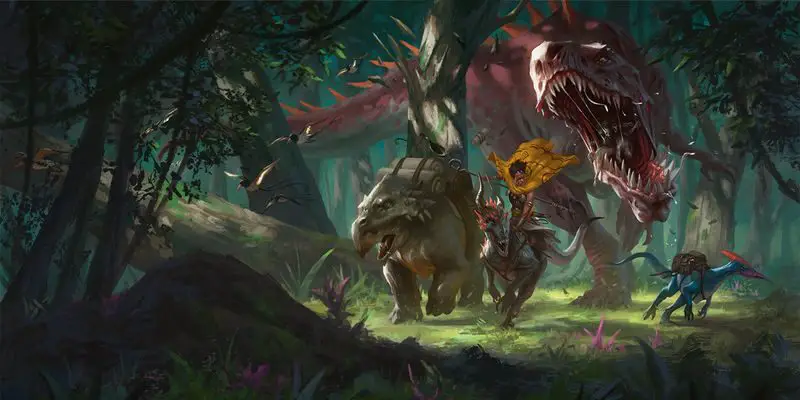Featured art “On a Quest” by NathanParkArt, CC License (cropped for our purposes).
This article contains affiliate links that add gold to our coffers.
Players and Dungeon Masters alike often find themselves immersed in an escapist high-fantasy fiction when playing Dungeons and Dragons, involving slaying mythical beasts and defending strongholds, kingdoms, and entire realms. While romantic and fulfilling in its grandeur, this somewhat anxiety-provoking type of high-stakes gameplay may not appeal to all players.
We just wrote about D&D Hard Mode, and now, in this article, I’m going to propose ideas for playing Dungeons and Dragons on Safe Mode, which suggests a lot less killing, significantly safer encounters, and yet still packed with intrigue and escapism.
Key Points of Low-Stakes D&D
Picture this: Your players are a ragtag team of investigators trying to solve a series of Jack-the-Ripper-esque murders, which are quite uncommon in such a civilized Victorian society. Though your team may engage in the occasional brawl and thug-knife fight, physical skirmishes are generally uncouth and risk your party’s occupations as police inspectors.
This setting involves high action, though not of the sword-and-spell kind. You can imagine a lot of the gameplay will be catered toward interrogating fascinating NPC’s, thickly tense standoffs between ruffian troublemakers and the law, and complex character development. In this campaign setting, the expectation is non-lethal damage in order to take persons of interest into custody. Death is reserved for the evil deeds of the murderous serial killer.
These are essentially the key principles of a low-stakes campaign: illustrious intrigue, profound character development, fascinating non-player characters, compelling verbal scenarios, non-lethal encounters that involve high-level strategy, and extensive performative roleplaying.
Explorable Worldbuilding
In a mild D&D setting, your world is a player’s proverbial second life without strict limitations of money and time. They may be inclined to explore, develop, build, and mold your world. This could involve traversing culturally-unique and vast cities, touring through biome-rich and captivating wilderness, or staking out fresh frontier land to develop their own settlements.
To avoid high-stakes encounters with packs of wild displacer beasts or tribes of goblins, a lot of your world could already be civilly developed, or your party could have a magical ward to repel dangerous beasts. Regardless, prepare uniquely interesting societies and allow players the opportunity and time to delve into it and possibly build upon it in terms of developing communities, homes, kingdoms, and so forth. Your “roleplaying” genre just morphed into “slice-of-life” and “simulation.”
Roleplayable Encounters
First off, we need to reframe what we consider an “encounter.” In Safe-Mode, encounters involve much less combat and far more roleplay and skill checks.
For instance, imagine a campaign in which your players are dukes and duchesses seeking to seize more power. They’ll likely be highly involved in political games and attempt to wiggle their way up or throw shade on their competitors. Readers familiar with the Wheel of Time series will recognize this as the Game of Houses, Daes Dae’mar: “political and social maneuvering employed by the nobility of various nations to gain status or wealth, or to cause the downfall of others they dislike.”
Further examples of safe-mode encounters include running a trial, protecting a wizard’s keep during a tumultuous storm, attending an important party or gathering, meeting with tribal diplomats to solve intra-societal differences, safe-cracking, or basically any tense situation where things could go wrong but the risk of fighting is minimal.
The benefit of running safe-mode encounters is that other character skills will be valued and utilized, such as animal handling, religion, survival, tools, musical instruments, and character knowledge. Set up encounters where these typically-unused skills and roleplay endeavors shine.
Interpersonal Intrigue
Planning a campaign in safe-mode doesn’t have to be boring, but it may require a type of player who is adept at or interested in roleplaying extensively. While characters who are itching for their axes could still enjoy a safe-mode campaign, escalating every encounter to an on-edge tense “will-they-won’t-they attack” scenario will not fly in this setting.
Rather, focus largely on developing characters through story and roleplay. We have released a free tool for developing character backgrounds that will help Dungeon Masters and their players get on the same page. You can download the spreadsheet here. When players have established goals, history, flaws, relationships, and personalities, Dungeon Masters will be able to utilize this knowledge to tailor and enrich roleplayable encounters for their players specifically.
Furthermore, Dungeon Masters should devise a web of intriguing relationships and connections between the characters and non-player characters. A good story connects all things in a (or many) satisfying and colossal reveal(s). These unveilings, like a good soap opera, are highly rewarding in a combat-sparse campaign.
Reserved Combat
In a safe-mode campaign, combat is still an option. Depending on the setting, players may only have simple weapons like batons or knives, or they may simply engage in non-lethal brawls. Perhaps taking the life of a sentient creature would weigh heavily on their conscience.
Situations where the players are in grave peril and wounded heavily would be rare and thus intensified. Yes, characters can still be mortally wounded in a mild D&D campaign, but these scenarios should be reserved for major climaxes in the story for full impact. All other combat should result in foes and players alike getting knocked out, apprehended, or running off.
Rather than outright killing your characters, consider giving them a lingering injury that affects their day-to-day significantly. Lingering injuries will also provide greater roleplay options and character development in further gameplay.
Campaign Hooks
There are a myriad of stories to tell in a low-stakes D&D campaign. Here are a few of our ideas:
- Players are young (or maybe some old) wizard apprentices training under a master or in a wizarding school.
- Players are city managers establishing and developing their city.
- Players are a group of low-key mages who solve problems for otherworldly beings in order to release them from their limbo.
- Players are a part of a research team endeavoring to reveal a mystery of the world.
- Players have been hired to fetch an object or resource from a rich widow.
- Players are mid-tier nobles who suspect political espionage among their peers.
- Players are archaeologists in search of remains and evidence of extinct creatures.
- Players are frontiersmen exploring new worlds.
- Players are performers, seeking patrons and preparing new and exciting entertainment.
- Players are cooks or housekeepers for nobles and fall in love with the son of the madam of the house.
- Players are running a business.
- Players are participating in the local Thieves’ Guild.
- Players have been asked to tend a Druid’s grove for some time.
- Players are socially awkward members of the service class who share an imaginary friend, who is all but imaginary.
- Players are sportsmen working toward a big competition.
- Players are artisans who sell their goods at festivals. They have been asked to participate at the largest upcoming jubilee in the country.
- Players are leaders of a refugee camp searching for new land to call home.
- Players must develop a settlement (finding clean water, finding a good place, securing the land, etc).
- Players are part of a cartography team (each may have different roles in the team).
- Players have been hired to find the king’s daughter a suitor.
- Players are bodyguards to a nobleperson.
- Players are sailors exploring the vast unknown.
- Players are investigators/police of a metropolitan area.
- Players are their country’s diplomats bringing together warring countries.
- Players are shopkeepers with an unexpected merchandise.
- Players are fortune tellers traveling with a carnival.
- Players are normal citizens in a specific historical time period and culture who experience the beauties and tragedies of life.
- Players are in their second to last year of schooling and part of a specific club (swimming, pollo, gambling, etc).
- Players are a group of friends who discover an unusual person with a magical secret.
- Players are a group of friends with their OWN magical secret (they can possess other people, they have telepathic skills, etc).
- Players are a group of peers involved in a complex love triangle/hexagon/polyhedral mess.
- Players are a group of friends who have somehow gotten sucked into the drama of solving a mystery.
Mechanics of Safe-Mode
Though the basics of D&D 5e will remain unchanged in a safe-mode game, there are some challenges to consider when establishing the world setting.
Player Classes
As mentioned above, characters with immense roleplayable skills will shine heavily in these campaign settings. Where encounters are very limited in fighting, some classes will not work well. For instance, if a player wishes to be a Barbarian, remind them that their skills will largely go unused, and their raging temperament might spoil the fun of their fellow players. Redirect them to a Fighter who can use Strength and tactics to the team’s advantage in brawls or jobs.
Other classes will have more skills depending on the plot hook: Bards are clearly great performers, artificers would be great merchants, rangers excel at exploration, and so forth.
In a campaign such as this, perhaps it is better to remove the idea of “classes” altogether. Check out our idea for running a class-free campaign and opt for rewarding players skills and feats based on their in-game decisions and interests.
Monsters / Beasts
How often do you come across a dangerous beast in your own life? Chances are, running into one is pretty slim unless you’re an avid mountaineer or deep-sea diver. Similarly, in a low-stake game, monsters and beasts that pose a threat will be few-and-far between. This will also open the doors to using unique and unexpected, possibly homebrew, creatures when the opportunity arises. Your players will not be extreme fighters, so prepare light encounters and secondary means of escape or defeat.
Magic Use
Magic can still be utilized in your campaign as a tool, but are there specific spells-types that are outlawed, like damage-dealing or person-controlling spells that infringe on a person’s rights? Do secret organizations use these magics nefariously? Consider this in your world-building and establish precise rules that your players will be aware of.
Economy
In a setting where day-to-day decisions are pertinent, a balanced and fulfilling economy may be key, as players will be focused on making money to achieve their goals. While the selling price of items from the Player’s Handbook or Dungeon Master’s Guide are adequate, consider the scale at which you pay characters. If players feel like they are making no progress toward their goals, they may lose interest in the campaign.
Conclusion
For players who experience anxiety at the urgency and peril created by typical games of Dungeons and Dragons, a low-stakes Safe Mode is ideal while still providing payoff and fulfilling escapism. Have you run a more slice-of-life campaign? What challenges have you faced as a Dungeon Master or Player in this? Let us know by casting Message to Opal using the form below!




